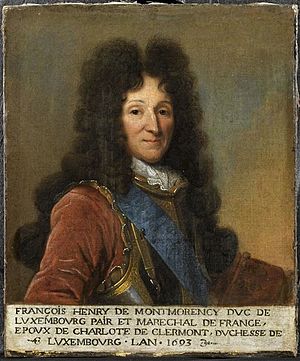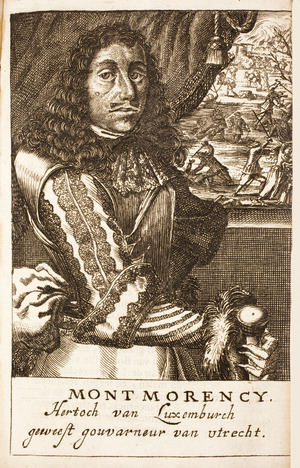François-Henri de Montmorency, duc de Luxembourg facts for kids
Quick facts for kids
François Henri de Montmorency-Bouteville, Duke of Piney-Luxembourg
|
|
|---|---|

Le Duc de Piney-Luxembourg
|
|
| Nickname(s) | Le Tapissier de Notre-Dame |
| Born | 8 January 1628 Paris, France |
| Died | 4 January 1695 (aged 66) Versailles, France |
| Allegiance | |
| Years of service | 1643–1694 |
| Rank | Marshal of France |
| Battles/wars | |
| Other work | Pair de France |
| Signature | |
François Henri de Montmorency-Bouteville, Duke of Piney-Luxembourg (born January 8, 1628 – died January 4, 1695), often called Luxembourg, was a famous French general. He was also known as "The Upholsterer of Notre-Dame" because he sent so many captured enemy flags to the Notre-Dame Cathedral in Paris.
Luxembourg became a Marshal of France, which is a very high military rank. He was a close friend and follower of the Great Condé, another brilliant French commander. Luxembourg was one of the best military leaders of his time. He was known for his victories in the Franco-Dutch War and the War of the Grand Alliance. Even though he was small and had a hunchback, he was a powerful general who never lost a battle when he was in charge.
Contents
Early Life and Family
François Henri de Montmorency was born in Paris, France. Sadly, his father was executed six months before he was born. This happened because his father took part in a duel, which was against the law.
His aunt, Charlotte Marguerite de Montmorency, who was a princess, took care of him. She raised him alongside her own son, the Duke of Enghien. François Henri became very close to his cousin, the Duke of Enghien (later known as the Great Condé). He supported his cousin through many challenges, including a civil war in France called the Fronde.
In 1659, François Henri was pardoned and returned to France. His cousin, Condé, helped him marry Madeleine de Luxembourg in 1661. She was one of the richest heiresses in France. After this marriage, he became the Duke of Luxembourg.
Luxembourg's Military Career
War of Devolution and Franco-Dutch War
When the War of Devolution began in 1667, Luxembourg first served as a lieutenant general under Condé. They helped conquer a region called Franche-Comté.
A few years later, in 1672, Luxembourg played a big role in the Franco-Dutch War. He led French forces against the Dutch. He won a battle against Prince William III of Orange at Woerden. However, his army was stopped by the Dutch Water Line, a defense system using flooded areas.
In 1673, Luxembourg made a famous retreat from Utrecht to Maastricht. He managed to move 20,000 soldiers safely, even though he was facing 70,000 enemy troops. This amazing feat showed everyone how skilled he was as a general. In 1675, he was promoted to Marshal of France.
In 1676, he took command of the Army of the Rhine. He tried to help the city of Philippsburg, which was under attack, but he couldn't break through the enemy lines. Philippsburg eventually fell. In 1677, he successfully attacked Valenciennes. He also defeated William of Orange again at Cassel. In 1678, he pushed back another attack by William at Saint-Denis.
After these victories, Luxembourg became very famous. He was briefly imprisoned in the Bastille in 1680. However, he was released and returned to his duties at court.
War of the Grand Alliance (1688-1697)
By 1690, during the War of the Grand Alliance, Luxembourg was put in charge of King Louis XIV's army in the Spanish Netherlands. On July 1, 1690, he achieved his greatest victory. He defeated the allied commander, the Prince of Waldeck, at the Battle of Fleurus.
The next year, he won another battle at Leuze in September 1691. In 1692, he protected the king's siege of Namur and defeated William of Orange again at Steenkerque.
On July 29, 1693, he won his most famous battle against William at Neerwinden. After this victory, he earned his nickname "The Upholsterer of Notre-Dame." This was because he sent so many captured enemy flags to the Notre-Dame Cathedral in Paris. He was celebrated in Paris, but King Louis XIV was sometimes cool towards him because of his connection to the Condé family.
In 1694, Luxembourg led a clever march from Vignemont to Tournai in front of the enemy, showing his skill even without a major battle.
Death and Legacy
When he returned to Versailles for the winter, Luxembourg became ill and passed away on January 4, 1695. Even though some people thought he was not always moral, he was considered one of the greatest generals of his time. He learned a lot from the Great Condé. While he might have been a bit lazy in planning campaigns, he was brilliant and quick-thinking during battles. His death marked the end of an important period in the military history of King Louis XIV.
Luxembourg was also known for his sharp sense of humor. Once, William of Orange reportedly said, "I never can beat that cursed humpback." Luxembourg famously replied, "How does he know I have a hump? He has never seen my back."
He had four sons. One of his youngest sons also became a Marshal of France, just like his father.
See also
In Spanish: François-Henri de Montmorency-Luxembourg para niños


